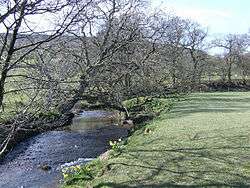River Dove, North Yorkshire
The River Dove is a river in North Yorkshire, England. It rises on the North York Moors and flows south to join the River Rye, itself a tributary of the River Derwent. The upper valley of the river is known as Farndale. The name is of Brittonic Celtic origin, meaning "dark river".[1] Its principal tributary is the Hodge Beck.
| River Dove | |
|---|---|
 The River Dove near Farndale | |
| Location | |
| Country | England |
| Physical characteristics | |
| Source | |
| • location | Farndale Moor, Nth Yorkshire |
| • coordinates | 54°24′24″N 1°2′23″W |
| • elevation | 372 metres (1,220 ft) |
| Mouth | |
• location | River Rye near Salton |
• coordinates | 54°12′7″N 0°54′35″W |
• elevation | 24 metres (79 ft) |
| Length | 30.22 kilometres (18.78 mi) |
| Basin size | 59.2 square kilometres (22.9 sq mi) |
Course
The river flows through Farndale south-east past several small settlements to Church Houses. Here it turns south and continues meandering past Low Mill to Lowna. At Gillamoor it heads south-east again past Hutton-le-Hole before returning southwards past Ravenswick and to the east of Kirkbymoorside. It continues past Keldholme and Kirkby Mills to Great Edstone. From there it flows south south-east to where it joins the River Rye in the Vale of Pickering near the village of Salton.
The Environment Agency have a gauging station at Kirkby Mills where the average low river level is 0.2 metres (0.66 ft) and the high river level 0.52 metres (1.7 ft) with a record high level of 2.45 metres (8 ft). The record high level shows the river can be susceptible to flooding.[2]
Geography
Both the River Dove and Hodge Beck are partly swallowed by the local limestone aquifer and issue again further down the valley. During summer months the bed of Hodge Beck often runs dry. The soil in the valley floor is loam over clay. The bedrock is Jurassic limestone with some sandstone.[3]
Leisure
Between Church Houses and Low Mill in Farndale, the River Dove is popular with walkers due to its picturesque setting. The banks of the river are known for their wild daffodils which are rumoured to have been planted by monks from nearby Rievaulx Abbey. Along this part of the valley is The Farndale Daffodil Walk, an 11.4-kilometre (7.1 mi) circular walk starting at Lowna Bridge.[4][5]
In literature
William Wordsworth's poem, She dwelt among the untrodden ways from the Lucy series of poems refers to the eponymous Lucy living close to the "springs of Dove", a possible reference to the source of the river, but could equally pertain to the either the River Dove in Derbyshire or in Westmorland, as Wordsworth knew of all three of them.[6]
Lists
Tributaries
|
Settlements
|
Crossings
|
Gallery
 Ford through the River Dove
Ford through the River Dove Footbridge Over the River Dove
Footbridge Over the River Dove Ford on the River Dove
Ford on the River Dove River Dove near Birch Hagg House
River Dove near Birch Hagg House Fishing Beat on the River Dove near Sparrow Hall
Fishing Beat on the River Dove near Sparrow Hall
Sources
- Ordnance Survey Explorer Map OL26
- Google Earth
References
- Watts, Victor, ed. (2010), "Dove", The Cambridge Dictionary of English Place-Names, Cambridge University Press
- "River Levels". Environment Agency River and Sea Levels. Retrieved 28 August 2011.
- "Geology". Retrieved 28 August 2011.
- "Walking". Retrieved 28 August 2011.
- "Farndale daffodils". Archived from the original on 27 September 2011. Retrieved 28 August 2011.
- Wordsworth, William (1958). Sharrock, Roger (ed.). Selected poems. London: W, Heinemann. p. 130. ISBN 0-435-15015-4.
External links
| Wikimedia Commons has media related to River Dove, North Yorkshire. |